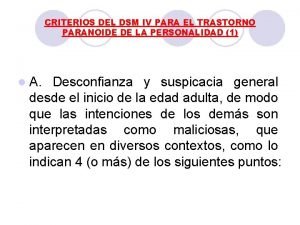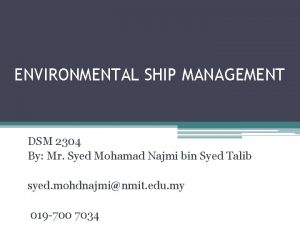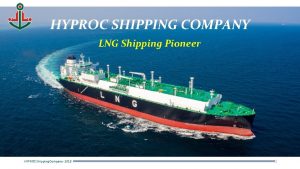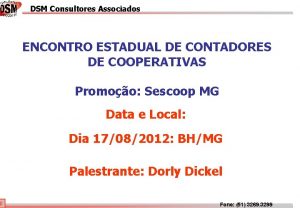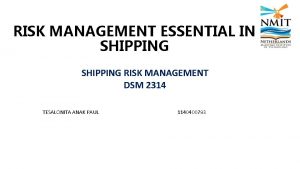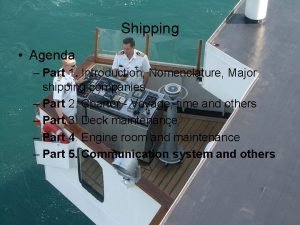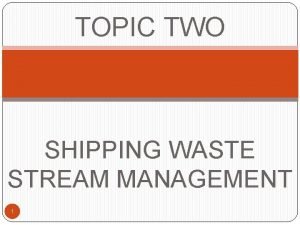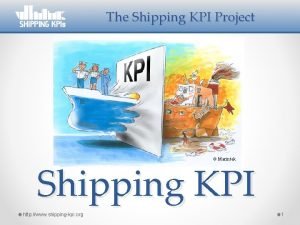MARKETING IN SHIPPING DSM 2307 Pandiyan Vadivelu Victor


















































- Slides: 50

MARKETING IN SHIPPING – DSM 2307 Pandiyan Vadivelu @ Victor , CMILT

COURSE LEARNING OUTCOME 1. Define different business scenarios in the context of marketing in Shipping and Export Management 2. Demonstrate knowledge and rationale of Marketing in Shipping and Export Management 3. Define Market Segmentation and describe Export Market Expansion Strategies 4. 5. 6. Develop a Shipping Marketing Plan Explain the socio, cultural and economic environment in the International Shipping Business Discuss Ethical Issues in international Ship Marketing Discuss Ethical issues in Ship Marketing

COURSE OUTLINE 1. International Shipping and Exporting 2. Introduction to international shipping business environment 3. Bases of International Shipping Marketing 4. Export Market Selection – Definition & Strategies 5. Strategic Marketing Impact of Shipping Organisation 6. Shipping Marketing Plan

1. INTERNATIONAL SHIPPING AND EXPORTING 1. 1 The nature of international marketing in shipping industry 1. 2 Export marketing and business strategy in shipping company 1. 3 Ethical and moral issues in shipping business 1. 4 Assessing foreign market opportunities: shipping ventures and port business

1. 1 The nature of international marketing in shipping industry q International marketing is the marketing of goods , services , and information across political boundaries. q Includes all the elements of domestic marketing : q Planning, promoting, distribution, pricing , and support of goods and services , information to be provided to the ultimate customers q More complex than domestic marketing q Need to accommodate key differences between home countries’ domestic environment and environment of foreign market q Differences include culture, consumer needs and wants , economic levels and structures, market structures and channels available , ways of doing business and laws and regulations International marketing and export management 7 th edition page 21

THE NATURE OF INTERNATIONAL MARKETING IN SHIPPING INDUSTRY q Any of the differences can make a company’s domestic approach to marketing ineffective, counter-productive or violation of law (page 21 -24) q The marketing manager need to know the target market, the differences that exist, and what to be done to accommodate the differences. There is availability of information. q Time spent on obtaining information is less than correcting costly mistakes

THE NATURE OF INTERNATIONAL MARKETING IN SHIPPING INDUSTRY q Business activities need to be done to accommodate the differences: q The analysis of market and potential market q The planning and development of products and services that consumers want , clearly identified in a suitable package q The distribution of products through channels that provide the services or conveniences demanded by purchasers

THE NATURE OF INTERNATIONAL MARKETING IN SHIPPING INDUSTRY q The promotion of products through advertising and personal selling to inform and educate consumers q Price setting to reflect value for money for the product and satisfactory profit / ROI. q Technical and non technical support given to customers (before & after) q The organisation structure, management and remuneration of foreign employees.

Questions and Discussion

2. 0 INTRODUCTION TO INTERNATIONAL SHIPPING BUSINESS ENVIRONMENT 2. 1 Major characteristic of economic shipping forces in industrialize nation 2. 2 Exploration of socio cultural environment of international shipping business 2. 3 The nature of business competition in shipping industry

MAJOR CHARACTERISTIC OF ECONOMIC SHIPPING FORCES IN INDUSTRIALIZED NATION q Major characteristics of economic shipping forces; market development and newly industralized nations(NIC) q NICs are countries whose economies have not yet reached developed country status but have, in a macroeconomic sense, outpaced their developing counterparts q NIC- China, India, South Africa, Brazil, Malaysia, Philipines , Thailand Turkey q Exploration of socio cultural environment of international shipping business: Egalitarians, pragmatist and traditional shipping business q The nature of business competition in shipping industry

NEWLY INDUSTRIALIZED COUNTRIES Newly industrialized countries

INTRODUCTION TO INTERNATIONAL SHIPPING BUSINESS ENVIRONMENT Economic forces are the factors that help to determine the competitiveness of the environment in which the firm operates. These factors include: Unemployment level Inflation rate Fiscal policies Government changes etc. These factors determine an enterprise’s volume of demand for its product and affect its marketing strategies and activities. The economic system is made up of three main steps. The first one being production, ad then there is distribution of the produced goods and then the last step is consumption.

MAJOR CHARACTERISTIC OF ECONOMIC SHIPPING FORCES IN INDUSTRIALIZED NATION q. Population q. Income and wealth distribution

EXPORT MARKETING AND BUSINESS STRATEGY IN SHIPPING Export marketing means exporting goods to other countries of the world. It involves lengthy procedure and formalities. q q In export marketing, goods are sent abroad as per the procedures framed by the exporting country as well as by the importing country. q business strategy is a long term plan of action designed to achieve a particular goal or set of goals or objectives Strategy is management's game plan for strengthening the performance of the enterprise. q It states how business should be conduct to achieve the desired goals. Without a strategy management has no roadmap to guide them.

EXPORT MARKETING AND BUSINESS STRATEGY IN SHIPPING q Strategy is important in shipping because : q facilitates the identification of business opportunities q gives an objective view to solve business problems q provides a framework to improve internal and external collaboration assists in controlling business activities, q minimizes negative effects when threats arise q helps make better decisions q guides effective allocation of resources q provides methods to manage changes q nurtures consistency in the management of the shipping business.

EXPORT MARKETING AND BUSINESS STRATEGY IN SHIPPING Shipping firms have a hierarchy of interrelated strategies, each formulated at a different level, which can be classified as corporate strategy, business strategy, and functional strategy. Formulating and implementing shipping strategies involve answering many interrelated decisions: What to do? When to do it? How to do it? The development of shipping strategies involves the process of strategic analysis, formulating strategies, and implementation and control of strategies. To seek business opportunities, a shipping firm needs to answer the question of how to structure the organization to sustain growth. The structural options for shipping firms include organic growth, acquisitions, joint ventures, alliances, and networks.

ETHICAL AND MORAL ISSUES IN SHIPPING BUSINESS q Ethical behavior is based on written and unwritten codes of principles and value held in society. It serves as a guide to behaviors on a personal level, within professions, and at the collective organizational level. q Moral : relating to principles of rights and wrong in behavior /conform to a standards of right behavior q morals are values that we attribute to a system of beliefs, be they religious, political or philosophical, for example. q Ethics are how business owners apply those beliefs in their short and long-term business decisions. q As a result, these concepts inevitably are intertwined and must be applied carefully to maintain an image of professionalism and accountability.

ETHICAL AND MORAL ISSUES IN SHIPPING BUSINESS q Business Ethics – Issues q A business cannot claim to be ethical firm if it ignores unethical practices by its suppliers – e. g. Use of child labour and forced labour q Production in sweatshops q Violation of the basic rights of workers q Ignoring health, safety and environmental standards q An ethical business has to be concerned with the behavior of all businesses that operate in the supply chain – i. e. v Suppliers v Contractors v Distributors v Sales agents

ETHICAL AND MORAL ISSUES IN SHIPPING BUSINESS q. Business conducted must moral and ethical weight. q There are many behaviors that are unethical in business and in life: Misleading people with inaccurate information Negligence in safety Financial misconduct Non-competitive practices like collusion Corruption and fraud Environmental damage/pollution

APPLICATION OF ETHICS IN BUSINESS q The product must be safe for use q Activities related to foreign market entry and expansion should not conflict with either home or local country values q Advertising and promotion should honestly represent product or service q Price should be set at reasonable level (Dumping and excessive pricing should be avoided) q Customers, employees, and suppliers should be treated in a equitable and proper manner

APPLICATION OF ETHICS IN BUSINESS q The product must be safe for use q Activities related to foreign market entry and expansion should not conflict with either home or local country values q Advertising and promotion should honestly represent product or service q Price should be set at reasonable level (Dumping and excessive pricing should be avoided) q Customers, employees, and suppliers should be treated in a equitable and proper manner

ASSESSING FOREIGN MARKET OPPORTUNITIES A market opportunity product or a service, based on either one technology or several, fulfills the need(s) of a (preferably increasing) market better than the competition and better than substitution-technologies within the given environmental frame (e. g. society, politics, legislation, etc. ).

ASSESSING FOREIGN MARKET OPPORTUNITIES q Assessing the market is an important part of the idea development process q Here are some common questions that should be answered as part of your assessment. q What problem will your company/product/service solve? q What value does your product/service/technology bring to the market? q Who is the expected market for these products and the market size? q What product or services will you take sales from? q Who will be your competitors or potential competitors?

3. BASES OF INTERNATIONAL SHIPPING MARKETING 3. 1 Potential benefits from export marketing and commercial freight management 3. 2 Introduction of International trade theories: freight rates, broking and routes 3. 4 The development of export in shipping companies 3. 5 Exporting and network model in shipping industry

POTENTIAL BENEFITS OF EXPORTING q Profit to exporter (Direct) q Profit to importer (Indirect) q Determined by impact on consumption and production q No country is self sufficient in every thing q Contribution of international trade is to welfare of domestic consumers q Active trade relationship between countries q Employment opportunities q Source of purchasing power for both foreign and domestic goods and services

3. BASES OF INTERNATIONAL SHIPPING MARKETING 3. 1 Potential benefits from export marketing and commercial freight management 3. 2 Introduction of International trade theories: freight rates, broking and routes 3. 4 The development of export in shipping companies 3. 5 Exporting and network model in shipping industry

POTENTIAL BENEFITS FROM EXPORT MARKETING & COMMERCIAL FREIGHT MANAGEMENT 1 Potential benefits from export marketing and commercial freight management 3. 2 Introduction of International trade theories: freight rates, broking and routes 3. 4 The development of export in shipping companies 3. 5 Exporting and network model in shipping industry

INTRODUCTION TO INTERNATIONAL SHIPPING BUSINESS ENVIRONMENT Major characteristics of economic shipping forces; market development and newly industralized nations(NIC) NICs are countries whose economies have not yet reached developed country status but have, in a macroeconomic sense, outpaced their developing counterparts NIC- China, India, South Africa, Brazil, Malaysia, Philipines , Thailand Turkey Exploration of socio cultural environment of international shipping business: Egalitarians, pragmatist and traditional shipping business The nature of business competition in shipping industry

NEWLY INDUSTRIALIZED COUNTRIES Newly industrialized countries

INTRODUCTION TO INTERNATIONAL SHIPPING BUSINESS ENVIRONMENT Economic forces are the factors that help to determine the competitiveness of the environment in which the firm operates. These factors include: Unemployment level Inflation rate Fiscal policies Government changes etc. These factors determine an enterprise’s volume of demand for its product and affect its marketing strategies and activities. The economic system is made up of three main steps. The first one being production, ad then there is distribution of the produced goods and then the last step is consumption.

INTRODUCTION TO INTERNATIONAL SHIPPING BUSINESS ENVIRONMENT WEEK TWO

The category of newly industrialized country (NIC) NICs are countries which have not yet reached developed country status but have, in a macroeconomic sense, outpaced their developing counterparts. Another characterization of NICs is that of nations undergoing rapid economic growth (usually export oriented). INTRODUCTION TO INTERNATIONAL SHIPPING BUSINESS ENVIRONMENT Incipient or ongoing industrialisation is an important indicator of a NIC.

INTRODUCTION TO INTERNATIONAL SHIPPING BUSINESS ENVIRONMENT In many NICs, social upheaval can occur as primarily rural, or agricultural, populations migrate to the cities, where the growth of manufacturing concerns and factories can draw many thousands of laborers. NICs usually share some other common features, including: Increased social freedoms and civil rights Strong political leaders. A switch from agricultural to industrial economies, especially in the manufacturing. An increasingly open-market economy allowing free trade with other nations in the world. Large national corporations operating in several continents. Strong capital investment from foreign countries. Political leadership in their area of influence. Rapid growth of urban centers and population.

Egalitarians, Pragmatist Traditional shipping business SOCIO CULTURAL ENVIRONMENT OF INTERNATIONAL SHIPPING BUSINESS:

SOCIO CULTURAL ENVIRONMENT OF INTERNATIONAL SHIPPING BUSINESS: Egalitarians Affirming, promoting, or characterized by belief in equal political, economic, social, and civil rights for all people. Pragnatist One who acts in a practical or straightforward manner; one who is pragmatic; one who values practicality Traditional Based on customs usually handed down from a previous generation

Socio cultural environment include: language Material culture Aesthetics Social organisation Religious beliefs Attitudes Values CULTURAL AND SOCIAL ENVIRONMENT Space and time OF INTERNATIONAL SHIPPING http: //www. exporthelp. co. za/modules/1_considering_exporting/env_sociocultural. html

NATURE OF BUSINESS COMPETITION IN SHIPPING A competitive industry Derived demand Compete on price or no price Liner shipping operates under oligopoly Tramp shipping operates under perfect competition Competition has led to rate wars and collapse of shipping companies. To restore order, consultation amongst shipping companies is needed.

NATURE OF BUSINESS COMPETITION IN SHIPPING Oligopoly market characteristics few sellers and inter-firm rivalry. Other characteristics of an oligopolistic industry include: High entry barriers to new-comers due to huge capital investment. Little difference in service. A few carriers that account for the majority of total supply.

NATURE OF BUSINESS COMPETITION IN SHIPPING Perfect competition (aka pure competition) All firms sell an identical product. All firms are price takers. All firms have a relatively small market share. Buyers know the nature of the product being sold and the prices charged by each firm. The industry is characterized by freedom of entry and exit.

Freedom to use highway Initial investment is small Greater mobility of ship High proportion of fixed cost Freedom of determination of rates Competition in tramp services Competition in liner services NATURE OF BUSINESS COMPETITION IN SHIPPING

PORTERS 5 COMPETITIVE FORCES AND SHIPPING SECTOR Porter identified five factors that act together to determine the nature of competition within an industry. These are the: Threat of new entrants to a market Bargaining power of suppliers Bargaining power of customers (“buyers”) Threat of substitute products Degree of competitive rivalry

PORTER’S COMPETITION MODEL

4. 0 EXPORT SELECTION : DEFINITION AND STRATEGIES 4. 1 Market definition and segmentation 4. 2 Export market expansion strategies 4. 3 Foreign market portfolios: techniques and analysis 4. 4 Assessing market potential: port development and freight rates

5. 0 STRATEGIC MARKETING IMPACT OF SHIPPING ORGANIZATION 5. 1 Issues in ethical marketing practices 5. 2 Marketing and corporate planning 5. 3 Forecasting 5. 4 Sales promotion 5. 5 Marketing research 5. 6 The product life cycle 5. 7 Pricing

6. 0 SHIPPING MARKETING PLAN 6. 1 Marketing audit 6. 2 SWOT analysis 6. 3 Marketing objective 6. 4 Marketing mix strategies 6. 5 Measurement of progress 6. 6 Contingency planning 6. 7 Budget 6. 8 The marketing planning process 6. 9 The benefits of marketing planning

REFERENCES 1. Album, G. & Duerr, E. ( 2011 ) International Marketing and Export Management (Seventh Edition), Pearson Education Limited, UK


Thank You

 Aaseevagam tamil
Aaseevagam tamil Childhood disorders dsm-5 ppt
Childhood disorders dsm-5 ppt Schizophreniform disorder icd-10
Schizophreniform disorder icd-10 Reality testing worksheet schizophrenia
Reality testing worksheet schizophrenia Dsm 4 y dsm 5 diferencias
Dsm 4 y dsm 5 diferencias Dsm ship management
Dsm ship management Tramp liner
Tramp liner Certificate of creditable tax withheld at source 2307 form
Certificate of creditable tax withheld at source 2307 form Certificate of creditable tax withheld at source 2307 form
Certificate of creditable tax withheld at source 2307 form Expanded withholding tax revenue regulation
Expanded withholding tax revenue regulation Psyc 2307
Psyc 2307 When new port shipping uses segmented marketing
When new port shipping uses segmented marketing Definición de autismo según el dsm 5
Definición de autismo según el dsm 5 Codependent personality disorder
Codependent personality disorder What are somatic complaints
What are somatic complaints Sensory processing disorder dsm
Sensory processing disorder dsm Difference in dsm 4 and 5
Difference in dsm 4 and 5 Personality disorders dsm 5
Personality disorders dsm 5 Egodystone
Egodystone Mood disorders
Mood disorders Dsm 5 axis
Dsm 5 axis Multiaxial diagnosis example
Multiaxial diagnosis example Flujograma eedp
Flujograma eedp Duygudurum bozuklukları dsm 5
Duygudurum bozuklukları dsm 5 Disturbi del neurosviluppo dsm 5
Disturbi del neurosviluppo dsm 5 Somatic symptom disorder vs factitious disorder
Somatic symptom disorder vs factitious disorder Dsm 5 mood disorder
Dsm 5 mood disorder Gender dysphoria dsm 5
Gender dysphoria dsm 5 Dsm 5 trastornos de la personalidad
Dsm 5 trastornos de la personalidad Generalized anxiety disorder dsm 5
Generalized anxiety disorder dsm 5 Bpd brain
Bpd brain Briquet sendromu
Briquet sendromu Yapay bozukluk dsm 5
Yapay bozukluk dsm 5 Asd levels
Asd levels Agoraphobia vs social phobia
Agoraphobia vs social phobia Dsm 5 stuttering
Dsm 5 stuttering Dsm 5 eksenleri
Dsm 5 eksenleri Dsm ship management
Dsm ship management Embocept
Embocept Salute mentale arezzo
Salute mentale arezzo Dsm topografia
Dsm topografia Autism criteria dsm 5
Autism criteria dsm 5 Dsm design structure matrix
Dsm design structure matrix Flujograma tepsi
Flujograma tepsi Dsm 5 kriterleri
Dsm 5 kriterleri Anksiyete nedr
Anksiyete nedr Design and implementation issues of dsm
Design and implementation issues of dsm Escala eeag
Escala eeag Diabulimia dsm 5
Diabulimia dsm 5 Quick fit enschede
Quick fit enschede Schizoaffective disorder
Schizoaffective disorder




























